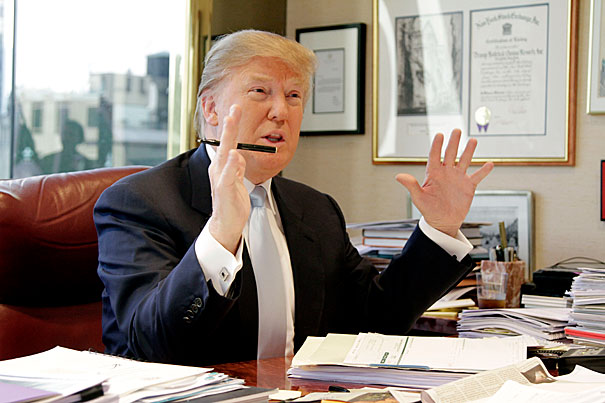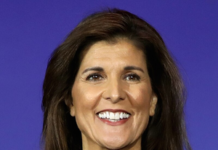By Christina Pazzanese
Harvard Staff Writer
During the 2016 campaign, Trump parlayed his fame as a celebrity real estate developer into a winning pitch to voters as a Washington outsider. Emphasizing his decades of experience as a wheeler-dealer building luxury hotels, casinos, and golf courses around the world, Trump pledged to use his business savvy and hard-charging leadership style to “drain the swamp” of the Washington bureaucracy and deliver results for the American people.

The United States is not a company, of course, and its citizens are not employees, but voters still were drawn to his promises of a fresh approach to governing. So what skills and perspectives might the wealthy businessman draw on as he transitions from CEO to commander in chief?
To get a better sense of the months ahead, The Gazette asked Harvard Business School (HBS) faculty members how Trump’s nearly 50 years of experience in building a global corporate empire might shape his approach to the presidency. Their insights follow.
Real estate rarely a zero-sum game
John D. Macomber
Senior lecturer of business administration
You have to start by distinguishing between a branding operation that’s supported by other activities, like Disney Hotels, and pure real estate [companies], like Boston Properties and Vornado. Trump is primarily a branding operation.
There are many sectors in real estate. Hospitality is one of them. In hotels, there are usually three parts to every deal. Usually, there’s one entity that owns the land and owns the building. There’s a different entity that likes to do operations like housekeeping and food and beverage. And there’s a third entity that has the brand. Companies like the Four Seasons or Ritz Carlton, we say they “flag” a hotel. They don’t manage it; they “flag” it. Trump has a few hotels, but mostly the properties are owned by other investors and he’s the “flag,” the name.
Given that case, that would inform a world view that has a high sensitivity to perceptions in what we call in real estate “the real economy.” Are the rooms full, and in which locations? Hotel people have a high sensitivity to what they perceive as “the financial economy.” They don’t know the inner workings, but “what are the interest rates?” They have high sensitivity to transactions and to partners, because everything’s a bespoke, one-off transaction. Typically, people like this also see the shared value. They seldom get into a zero-sum negotiation. They think, “How can we help each other?”
You’d expect someone like this to be very transactional, with a very high sensitivity to perception of current events, with a very high sensitivity to perceived financial prices, if not the inner workings of the financial market, and extremely high sensitivity to brand: What are people thinking? And you’d expect a much lower sensitivity to administration, to structure, to organizational dynamics, to long-term view, and to capital spending.
The incoming president has a really good sense for what people want to buy in that demographic. But going forward, one would expect that the temptation would be to continue to play your strong suit and try and express your own taste and your ideas because it’s worked for you for 50 years.
The second issue you’d expect of anybody in this situation would be that they’re probably quite confident in their own judgment. Having a very long record of reinforcement in making good decisions, for anybody, that would make them think they’ll be expert in other areas, whether it’s aviation or welfare or defense.
I think an early indicator will be: Can he persuade a different group of people? He’s so good at persuading the people he knows, but can he persuade Congress to act? If he’s a good communicator and good negotiator and good creator of shared value, he’ll figure out something that works for House Speaker Paul Ryan and for Senate Minority Leader Chuck Schumer. A second thing to look for is how much leeway does he really give to someone like Secretary of State nominee Rex Tillerson or to Wilbur Ross, the Commerce Department nominee, or to Vice President Mike Pence? It looks like he’s a person who hasn’t delegated a lot in the past. So those would be early things to see. And then there’s what he’d do in a crisis. From what’s been reported by the press, the crises in the past, he’s been able to bluster through. There may be different crises here, where it’s not a question of, say, talking firmly to your bankers.
For the most part, it looks like he’s always had the choice to walk away. In most of these project negotiations, he’s had a chance to do that. In the presidency, there will probably be negotiations — with Congress, with other nations, or with agencies or with all the people a president deals with — where you have to make a deal, and walking away is not a choice. It’ll be interesting to see how well he can create shared value in that context.
A lot of negotiations are also about leverage, and for the most part, he’s gotten himself in a very favorable position where he usually has the negotiating leverage. He may not have the leverage going forward. It’ll be interesting to see how he handles that. And can he use those negotiating skills and those communication skills and create shared value skills in a situation where there’s no walk-away option and he doesn’t have the leverage.
“Command and control” management model
Nancy F. Koehn
James E. Robison Professor of Business Administration
I study business leaders, government leaders, religious leaders, social activists, and other individuals — past and present — who exercise real, worthy impact. As a historian, I don’t see huge differences among political and business leaders in terms of what makes them effective. Courageous, serious leaders are men and women who are animated by a big, honorable mission, who get things done to achieve that mission, who demonstrate consistent emotional awareness as they do this, who motivate others to try to be better and bolder in pursuit of this purpose, and who work (tirelessly) to become better leaders themselves while they are doing all these other things.
Thus far, we have not seen much evidence — either along the campaign trail or since the election — that Mr. Trump meets most of these criteria. But I think many voters perceived him as being successful in getting things done. Some of this perception was likely a result of his public confidence. Some may have resulted from his bluntness and his stated intent to cut through the red tape of Washington, along with its perceived stagnation, dominance by big money, and the sense that so many Americans have that the federal government is run by a small number of people calling all the shots.
I think his hard-charging tone, coupled with his willingness to single out certain groups — from the media to Muslims to women to Hispanics — as responsible for many of the nation’s problems unleashed reservoirs of frustration, anger, and fear among certain groups of Americans. History makes it clear that all leaders have to be able to understand and respond to emotional currents among the people they influence. And I think Trump did that on the campaign trail in ways that served his political purposes very well. It is much less clear that inciting such animosity — and indeed hatred — among certain groups of Americans toward their fellow citizens will serve our country well. Certainly, history offers no such assurances. In fact, leaders who have risen to power by relying heavily on collective anger and discrimination toward other groups have proven to be despots, tyrants, and men who destroy the values and institutions that lie at the heart of democracies.
Homing in on Trump’s reputation as a hard-charging man of action, we can perhaps think about his management style as one of “command and control.” This is a description in which the company, organization, or enterprise runs as a kind of military operation in which everyone lines up and falls in line. Although in the early 20th century many businesses were structured along such lines, “command and control” organizations have become much less common — outside of the military — in the last 40 or 50 years. Today, businesses and other enterprises are flatter, much less hierarchical, and much more diverse than the companies that first grew to great scale and came to define the modern industrial economy. This evolution is partly a result of globalization and the fact that many large organizations have become much more interdependent and complex; one-size-fits-all no longer works so well. This development is also a function of social, economic, and political change. Leaders now have to deal with a much broader set of stakeholders, including citizens, consumers, and labor around the world in a way that they simply didn’t half a century ago.
At the same time, business has become responsible for much more than simply “selling high and buying low” and “delivering a healthy return for shareholders.” Today, companies are being held accountable for a whole host of social and political issues, from labor practices to environmental policies. In this context, hard charging and “command and control” are perhaps overly blunt instruments.
I write and teach about individual leaders concerned with an honorable purpose, men and women who succeed against great odds. The people I study — from the explorer Ernest Shackleton to Abraham Lincoln to the environmentalist Rachel Carson — all have a great deal of deftness, meaning they understand the precept: “In this particular situation, what do I need to do to move my mission forward?” They also have great reserves of emotional awareness, which they apply to themselves and the people they are trying to influence. From this perspective, it seems to me that if you’re always on a hard-charging default drive, then it’s very difficult to pause and summon up the suppleness, care, and emotional acuity that leaders need in high-stakes situations.
I think the incoming president has been very successful in terms of how he’s managed the American media to his ends. I can count on two hands the number of leaders I have seen in my lifetime who could walk into a room, take the measure of a large crowd so quickly, and then move into that energy and bring them along to embrace his agenda at a given moment. He has done this over and over, not only among his political supporters, but also among reporters and other members of the press.
Despite these skills, which require some foresight, he appears to be extraordinarily reactive in his emotions, in his declarations, in the very heavy hammer that he wields across the board on different subjects as they come up, in real time, using social media. This is unprecedented. There is nothing in American history that compares with this aspect of his behavior: a public candidate and now president-elect, who is not only willing but eager to raise the public temperature so significantly, so often, and on such a widespread basis.
When I reflect on strong leaders, I usually see an important connection between a given individual’s decisions and his or her respect for the organization for which that person is responsible. Government leaders make choices affected by laws and the founding documents of a nation; judges issue decisions anchored in precedent; CEOs consider the values and mission of their companies; even disruptive entrepreneurs struggle to build an organization that will execute a larger end and then endure. This connection is critical because a worthy leader wants the people whom he or she motivates to respect the organization and to serve that enterprise from such a place. This means a leader is always working to deepen the sense of integrity that his or her followers accord the organization, including its values, its charter, and those charged with serving as stewards of these critical aspects. We have yet to see Mr. Trump evidence such respect or incite it among his fellow Americans.
Anyone we would say was an effective leader had the respect of his or her organization and toggled always back and forth between “what does this mean for the trajectory and the integrity and the character and the identity and the stability of my organization?” and “how is that related to my actions?” And that critical umbilical cord is, from my vantage point, not in sight here. I don’t see it. And I’m most troubled by that.
“Push” and “pull’ marketing to build public support
John A. Quelch
Charles Edward Wilson Professor of Business Administration and professor in health policy and management at the Harvard T.H. Chan School of Public Health
Marketing is important in campaigning. It is equally important in governing. In 2008, Barack Obama won the presidency with an uplifting call for hope and change. He leveraged online media to attract volunteers and donors, building a swell of grassroots support. In 2016, Donald Trump also leveraged new media, notably Twitter, to generate grassroots support around his call to make America great again. Effective communications and wise targeting of resources against key voter segments, notably in swing states, were equally important in both cases.
Marketing in the world of politics is different from marketing in the world of commerce. In politics, you need majority support or at least a plurality to be successful. In commerce, you can be highly profitable as a niche brand appealing to a narrow segment of the population. In fact, being all things to all people is a recipe for disaster. The other noteworthy distinction is that the presidential marketer needs to win the vote on one day every four years, whereas the commercial marketer needs the cash register to ring every day.
Nevertheless, public opinion is important to any president, and President Trump enters office with a low popular approval rating. That will require him to hone his communications skills and to win over many people who remain skeptical of his motives and competency. He must consciously set out to escape the Washington bubble and stay in touch with the ordinary voters from whom he draws much of his energy and confidence. Their continued enthusiasm to lobby their senators and representatives will be important to his ability to legislate his campaign promises.
Governing as president therefore requires a combination of “push” and “pull” marketing. Coca–Cola pushes its products through retail distribution and at the same time advertises directly to consumers to generate demand that pulls the product off retail shelves. In the same way, President Trump must push his agenda through Congress, but strong popular support backing the agenda will help persuade legislators to vote accordingly.
A likely force benefiting small business
Karen Mills
Former administrator of the U.S. Small Business Administration (SBA) and now a senior fellow at HBS and at the Mossavar-Rahmani Center for Business and Government at Harvard Kennedy School
Having a businessman in the White House has the potential to change the conversation in America around small business. Indeed, President Trump’s business background, if applied in the right way, could help him understand the needs of American small business. There are certainly thousands of small businesses that hope this will be the case.
However, to do this right, President Trump needs to step up the focus on small business and ensure this critical part of our economy is part of every economic discussion his team has. So far, his attention seems to be on big business — aside from his nomination of Linda McMahon as SBA administrator. Big business often has significantly different needs from small business. Small businesses have a more difficult time accessing capital, providing health care to their employees, navigating complex regulations at every level of government, and much more. His promises to cut taxes and reduce burdensome regulation for small businesses could be a good start. But on both of these fronts, the policy details will matter when it comes to what small businesses need to grow and succeed.
On the regulatory front, as I have written in a recent working paper, small business lending falls through the cracks of our current oversight framework. Small businesses and lenders should push President Trump to streamline the current “spaghetti soup” of regulation that is supposed to ensure greater access to capital, transparency, and borrower protections. Small businesses could also benefit from more incentives for large companies, which stand to get significant tax breaks under a Trump administration, to give more of their supply chain contracts to U.S.-based small businesses. In addition, National Federation of Independent Business surveys show that access to affordable health care is a top small business priority. Obamacare began to address this issue through the SHOP [Small Business Health Options Program] exchanges, but “Trumpcare” could go further in ensuring affordable rates for small businesses.
Small businesses should advocate for President Trump to treat them like the customer, something that can be done by leveraging technology and innovation in ways that streamline interactions with federal agencies, like online form filing.
Stars align to fix a broken tax system
Mihir Desai
Mizuho Financial Group Professor of Finance and professor of law at Harvard Law School
The stars are in alignment for a major tax reform under President Trump. Thirty years of inaction on tax reform, along with significant changes in the economy and other countries’ tax policies, has made the U.S. tax system unwieldy and problematic in many ways. Most obviously, the corporate tax has become a dominant factor in the market for corporate control (i.e., so-called inversions), financing patterns (i.e., cash holdings), and profit-shifting activities (i.e., transfer pricing of profits).

In short, it’s broken and we have the worst of all worlds relative to the rest of the world. We have high marginal rates that distort incentives, especially on profit-shifting, and only middle-of-the-pack average tax rates. The ratio of tax-induced distortions to revenue is creeping higher every year.
The individual tax side of things is not quite as broken, but is overgrown and not serving our needs. We have numerous overlapping and confusing incentives on education, health, and child care expenses that ultimately limit the uptake of these programs. We have enacted several stealth tax increases that are quite large by phasing out deductions and exemptions. And, broadly speaking, the tax system may not reflect the apparent current support for more redistribution. One reason for that is the top bracket used to contain 0.1 percent of the taxpayers and now has 1 percent of the population. This creates resistance to increased top marginal rates.
Finally, the usual guiding lights of equity and efficiency in tax policy now have to be complemented with a third concern: complexity. In the globalized world, there are ever-more margins on which economic agents can respond to complexities through planning. The overly complex system, especially on the international corporate side, is becoming a planner’s paradise.
What will President Trump do? His plan during the campaign was admirable in some ways. The simplicity of the rate structure for individuals, the expansion of the standard deduction, the limitation on deductions, and the reduced corporate rate were broadly sensible. But, there were critical mistakes, including repeal of international deferral and a minimum tax for corporate foreign source income. It was fiscally irresponsible and not attuned to current tastes for redistribution.
Given the relative inexperience of most of the current Trump economic team on these issues, I would expect that House Speaker Paul Ryan will dictate the broad outlines of any proposed legislation. His proposal, also known as the Ryan-Brady plan, is not just a renovation or a gut-rehab, it’s a teardown. It shifts the base of taxation to consumption from income through a “destination-based cash flow tax.” In effect, it is a form of value-added tax (VAT). Corporations will face a considerably lower rate, will not be allowed to deduct interest payments, and will be allowed to expense investments. The easiest way to understand that is: Because all business-to-business transactions are effectively deductible, the tax base becomes business-to-consumers transactions. In other words, consumption.
One of the most important wrinkles in this system is that export revenue would be exempt from taxation, and the costs of imports would not be deductible under what is known as “border tax adjustments.” This has the potential for being incredibly redistributive across sectors, as exporters would have tax losses as far as the eye can see and importers would have much larger taxes due, unless exchange rates adjust to neutralize these changes in taxation, as economic theory would suggest.
Will they? It’s hard to say because nothing on this scale has ever been attempted. Moreover, the plan has numerous question marks over how it would work. How would financial institutions get taxed? Would pass-through entities have their current treatment? Most importantly, it’s not clear it would pass muster with the World Trade Organization.
The key advantage to Trump of the Ryan-Brady plan may well be the ability to characterize the border tax adjustments as tariffs. The box he put himself in regarding protectionist measures can be escaped by implementing the plan and labeling those adjustments as tariffs even though they’re not really functioning in that way. From an economic perspective, that deceit is preferable to the realities of tariffs. In recent tweets on auto companies, he’s already changed his language to a “border tax,” from tariffs.
I think the risks of such a dramatic tax change are too great to justify the teardown. I’d prefer to see corporate tax reform proceed in a revenue-neutral way, with reduced rates and a shift to territoriality funded by changing the treatment of pass-throughs and by aligning the characterization of profits to tax authorities and capital markets. On the individual side, I think a significant expansion of the earned-income tax credit, unification and simplification of various credits and deductions, and a new top bracket for individuals making more than $1 million would help enormously.
How does Trump’s business background condition his policy preferences and methods? It’s critical to realize that real estate development is quite unique in business, and the traits that allow you to succeed, to the degree he’s succeeded, in that field are not necessarily representative of the traits required elsewhere in business.
Real estate development requires much more sharp-elbowed negotiating, coalition building between organizations, and marketing savvy than most types of business. It also tends toward monumental efforts rather than incremental change. Those skills might help him quite a bit in the Washington of today. Unfortunately, they could also result in a tweet-driven assemblage of hollow gestures (saving jobs via jawboning) without any real substance.
These interviews have been edited for length and clarity.
(Published with permission from Harvard Gazette.)















